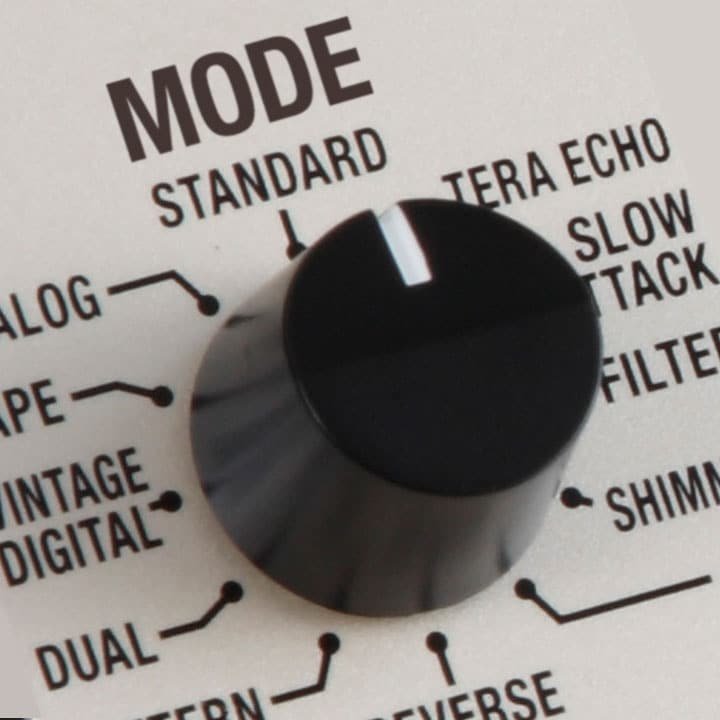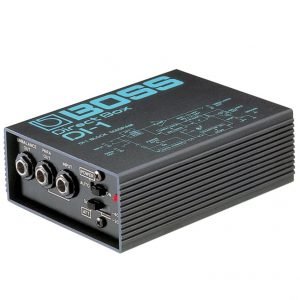The BOSS DD-500 Digital Delay is BOSS’ flagship, multi-mode delay pedal. With exceptional sound quality and customisable flexibility, the DD-500 is an absolute powerhouse of a delay, able to handle practically any delay-related task you assign to it.
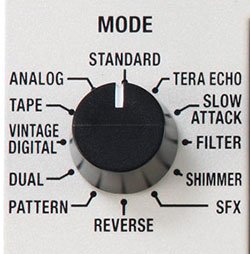 The core of the DD-500’s gigantic flexibility is the varied delay modes available for selection, accessible via the MODE knob on the front panel.
While all of these modes are fundamentally delays, they are all different and have contrasting qualities to them which make for a diverse and inspiring palette of sound options to choose from.
You’ve probably heard many of these mode terms used before – Standard, Analog, Shimmer, Reverse, Filter, Tape…sure, they might sound self-explanatory, but what do they actually do to your sound?
One way to find out of course is to try them yourself, but if you can’t access the particular pedal that you’re after, it might be difficult to fully appreciate what these delay modes can do for you.
In this article, we’ll show you the differences between the 12 different delay modes available on the BOSS DD-500 and perhaps give you a little bit of insight as to how you might use them. In fact, to get started with some practical application – here’s a video of all 12 modes of the DD-500 in action:
Let’s take a closer look at what each Mode does and discuss how you can use each one.
Contributed by Byron Struck for the Roland Australia Blog
The core of the DD-500’s gigantic flexibility is the varied delay modes available for selection, accessible via the MODE knob on the front panel.
While all of these modes are fundamentally delays, they are all different and have contrasting qualities to them which make for a diverse and inspiring palette of sound options to choose from.
You’ve probably heard many of these mode terms used before – Standard, Analog, Shimmer, Reverse, Filter, Tape…sure, they might sound self-explanatory, but what do they actually do to your sound?
One way to find out of course is to try them yourself, but if you can’t access the particular pedal that you’re after, it might be difficult to fully appreciate what these delay modes can do for you.
In this article, we’ll show you the differences between the 12 different delay modes available on the BOSS DD-500 and perhaps give you a little bit of insight as to how you might use them. In fact, to get started with some practical application – here’s a video of all 12 modes of the DD-500 in action:
Let’s take a closer look at what each Mode does and discuss how you can use each one.
Contributed by Byron Struck for the Roland Australia Blog
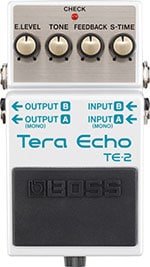 TERA ECHO: One of BOSS’ newer effects (along with being the 100th BOSS pedal!) the Tera Echo is an echo sound that falls between both reverb and delay. It has a lot of space and adds a certain animated and lively quality to the delay sound that is excellent for ambience.
Tera Echo on the DD-500 is based on the MDP powered stompbox pedal of the same name. Combining elements of delay, filtering, reverb and pitch modulation, the complex sound produced by this effect is perfect for ambient washes or subtle reverberation with a slight edge.
Certainly one of the most exciting new innovative effects of recent times, the Tera Echo sounds incredible on clean tones for a sparkly, modulated result. However, if you use it with some overdrive or distortion, you’ll hear the highly expressive quality of its multi-faceted sonic abilities in soaring detail!
SLOW ATTACK: Slowly fades the delay effect in by affecting the attack of the delayed signal. Similar to if you were to use a volume pedal or your guitar’s volume control. Great for bringing the delay in gradually after you play something, for a building kind of sound.
You can use the Slow Attack mode to produce stunning and highly imaginative “bow-like” sounds that perfectly lend themselves to big chords, epic leads lines and clean swells. Combined with other effects like reverb and phase, you can create mesmerising soundscapes with the Slow Attack.
And, if you swap your volume pedal out for an expression pedal from the BOSS EV series line, you can now let the Slow Attack take care of your swell time and focus on controlling different aspects of your delay sound via the DD-500’s parameters, including Mod Depth or even the delay time and feedback!
FILTER: Adds a sweeping filter to your delayed signal, similar to a phaser or a flanger. Use if you want the delay sound affected by a modulation effect.
Combining a filter with a delay is like a guitar played through an overdriven amplifier – it makes perfect sense. Not only do you have the benefit of a new space added to your sound, but you’re now affecting that space with movement and a new texture.
Augmenting the original signal with new elements, highlighting your delay sound with new colours and being able to control all of these factors is ideal for taking your music into new territory. Plus, you’ll save space on your pedalboard if you want to leave your phaser or flanger at home.
For rhythmic and percussive effects, this mode is perfect. For dreamy, psychedelic washes, it works a charm. For combining multiple classic effect parameters into a highly usable and dynamic delay setting, try the Filter mode of the DD-500.
SHIMMER: A unique effect that lends a lush, textural and somewhat ethereal quality to the sound, created by pitch-shifting the delayed portion of your sound.
“Shimmer” is a term that came to prominence when artists began combining harmonizing and other pitch-based effects with delay. Originally, these different effects units were independent of each other, so for example, a delay signal was fed into a pitch-shifting unit.
This resulted in a shimmering quality to the delay sound, wavering as it progressed over time. As the “Shimmer” effect grew in popularity, it started to appear as a selectable mode on delay and other effects units, right up to today.
Because of the combination of different effects all working on your sound, the complex results that the DD-500’s Shimmer mode can deliver makes for a fantastic accompaniment to clean arpeggios. This is where you can really hear the individual note pitches shifting, after you play each one separately.
Of course, there are no rules, so experiment with the DD-500’s Shimmer mode and discover what works best for you!
SFX: Takes your delay signal and introduces a sound affecting element to it. Use for a more unusual delay signal.
Similar to the “Bit Crush” effect that has enjoyed recent popularity, the SFX mode reduces the resolution of your delay signal. This creates a lo-fi, buzzing and glitching kind of sound, similar to if you were playing an early video game!
It also has the ability to add a tremolo effect to your sound, resulting in a wavering, shaky and almost synth-like effect. The SFX mode is an unusual sounding effect for unusual purposes, but that doesn’t mean that you have to stay regulated to the world of weird sounds with it.
Using the modulation elements subtly can enhance your delay tone, giving a rough and slightly textural edge to an otherwise straightforward delay sound.
REVERSE: Reverses the delay signal, providing a backwards effect. Great for psychedelic sounds.
Certainly a more unusual-sounding delay effect, the Reverse mode might take a bit of experimenting if you’ve never played with it before. But once you get the hang of it, it’s an infinitely rewarding feature. When engaged, you’ll hear the decay of the last note you played first and the first note you actually played, last!
Similar to the “bowing” sound that the Slow Attack mode can produce, the Reverse mode will give you strange rise and fall sounds that sound even weirder once you employ extra parameter manipulation with the CTL switches.
Sure, it’s not a mode you’d use on everything but as a unique addition to your sound palette, it’s definitely worth exploring. And don’t forget, you can always store and recall a particular patch setting that you like!
PATTERN: This mode has 16 choices within it, with each one able to be set differently. It provides a rhythmic sequence to the affected signal, perfect for adding a choppy, pulsating kind of element to your delay sound.
TERA ECHO: One of BOSS’ newer effects (along with being the 100th BOSS pedal!) the Tera Echo is an echo sound that falls between both reverb and delay. It has a lot of space and adds a certain animated and lively quality to the delay sound that is excellent for ambience.
Tera Echo on the DD-500 is based on the MDP powered stompbox pedal of the same name. Combining elements of delay, filtering, reverb and pitch modulation, the complex sound produced by this effect is perfect for ambient washes or subtle reverberation with a slight edge.
Certainly one of the most exciting new innovative effects of recent times, the Tera Echo sounds incredible on clean tones for a sparkly, modulated result. However, if you use it with some overdrive or distortion, you’ll hear the highly expressive quality of its multi-faceted sonic abilities in soaring detail!
SLOW ATTACK: Slowly fades the delay effect in by affecting the attack of the delayed signal. Similar to if you were to use a volume pedal or your guitar’s volume control. Great for bringing the delay in gradually after you play something, for a building kind of sound.
You can use the Slow Attack mode to produce stunning and highly imaginative “bow-like” sounds that perfectly lend themselves to big chords, epic leads lines and clean swells. Combined with other effects like reverb and phase, you can create mesmerising soundscapes with the Slow Attack.
And, if you swap your volume pedal out for an expression pedal from the BOSS EV series line, you can now let the Slow Attack take care of your swell time and focus on controlling different aspects of your delay sound via the DD-500’s parameters, including Mod Depth or even the delay time and feedback!
FILTER: Adds a sweeping filter to your delayed signal, similar to a phaser or a flanger. Use if you want the delay sound affected by a modulation effect.
Combining a filter with a delay is like a guitar played through an overdriven amplifier – it makes perfect sense. Not only do you have the benefit of a new space added to your sound, but you’re now affecting that space with movement and a new texture.
Augmenting the original signal with new elements, highlighting your delay sound with new colours and being able to control all of these factors is ideal for taking your music into new territory. Plus, you’ll save space on your pedalboard if you want to leave your phaser or flanger at home.
For rhythmic and percussive effects, this mode is perfect. For dreamy, psychedelic washes, it works a charm. For combining multiple classic effect parameters into a highly usable and dynamic delay setting, try the Filter mode of the DD-500.
SHIMMER: A unique effect that lends a lush, textural and somewhat ethereal quality to the sound, created by pitch-shifting the delayed portion of your sound.
“Shimmer” is a term that came to prominence when artists began combining harmonizing and other pitch-based effects with delay. Originally, these different effects units were independent of each other, so for example, a delay signal was fed into a pitch-shifting unit.
This resulted in a shimmering quality to the delay sound, wavering as it progressed over time. As the “Shimmer” effect grew in popularity, it started to appear as a selectable mode on delay and other effects units, right up to today.
Because of the combination of different effects all working on your sound, the complex results that the DD-500’s Shimmer mode can deliver makes for a fantastic accompaniment to clean arpeggios. This is where you can really hear the individual note pitches shifting, after you play each one separately.
Of course, there are no rules, so experiment with the DD-500’s Shimmer mode and discover what works best for you!
SFX: Takes your delay signal and introduces a sound affecting element to it. Use for a more unusual delay signal.
Similar to the “Bit Crush” effect that has enjoyed recent popularity, the SFX mode reduces the resolution of your delay signal. This creates a lo-fi, buzzing and glitching kind of sound, similar to if you were playing an early video game!
It also has the ability to add a tremolo effect to your sound, resulting in a wavering, shaky and almost synth-like effect. The SFX mode is an unusual sounding effect for unusual purposes, but that doesn’t mean that you have to stay regulated to the world of weird sounds with it.
Using the modulation elements subtly can enhance your delay tone, giving a rough and slightly textural edge to an otherwise straightforward delay sound.
REVERSE: Reverses the delay signal, providing a backwards effect. Great for psychedelic sounds.
Certainly a more unusual-sounding delay effect, the Reverse mode might take a bit of experimenting if you’ve never played with it before. But once you get the hang of it, it’s an infinitely rewarding feature. When engaged, you’ll hear the decay of the last note you played first and the first note you actually played, last!
Similar to the “bowing” sound that the Slow Attack mode can produce, the Reverse mode will give you strange rise and fall sounds that sound even weirder once you employ extra parameter manipulation with the CTL switches.
Sure, it’s not a mode you’d use on everything but as a unique addition to your sound palette, it’s definitely worth exploring. And don’t forget, you can always store and recall a particular patch setting that you like!
PATTERN: This mode has 16 choices within it, with each one able to be set differently. It provides a rhythmic sequence to the affected signal, perfect for adding a choppy, pulsating kind of element to your delay sound.
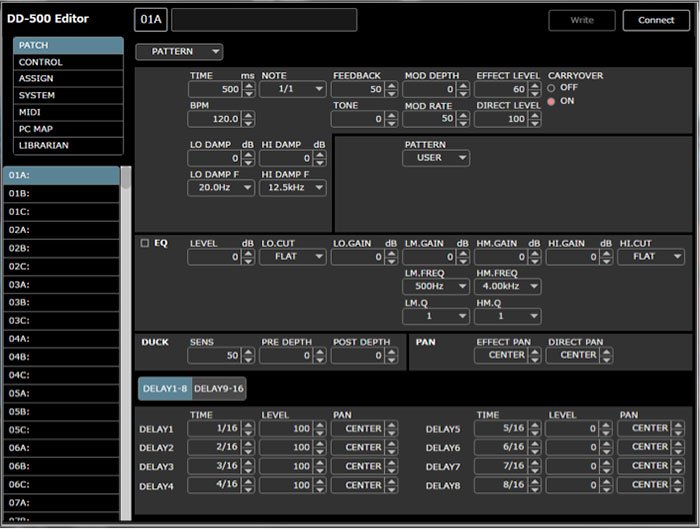 This is the kind of mode with which you can really add movement and a sense of dynamic evolution to your music. Where it can get really fun is if you use the DD-500’s MIDI functionality to tempo sync the Pattern delay to (or as) a Master Clock.
Do this with a drum machine like the TR-8, a DAW or any other device you’d like to jam and stay in perfect time with! As a pulse for other instruments to work around as well, you can essentially become the rhythmic backbone in an ensemble situation with this mode.
DUAL: This is a two-in-one kind of delay mode. It’s like having two different delay pedals on different settings working on your input signal at the same time! The delays can be in series or parallel (that is, you can have one delay follow the other, or have them both affecting your input signal at the same time before merging).
With this mode, you could have a shorter delay time and a longer delay time simultaneously, for creating fascinating and evolving spatial repeats. The different delay times are able to link with each other and you can also select the feedback level for each delay.
Level control for each delay is also able to be dialled in so you can have twin Tape or Shimmer delays independently working on your sound, for spectacular results!
VINTAGE DIGITAL: Reproduces the sound of early digital delay, which was predominant in the early 1980s. Similar to the BOSS DD-2, the world’s first stompbox delay pedal and Roland’s famous SDE-2000 and SDE-3000 rack units.
This is the kind of mode with which you can really add movement and a sense of dynamic evolution to your music. Where it can get really fun is if you use the DD-500’s MIDI functionality to tempo sync the Pattern delay to (or as) a Master Clock.
Do this with a drum machine like the TR-8, a DAW or any other device you’d like to jam and stay in perfect time with! As a pulse for other instruments to work around as well, you can essentially become the rhythmic backbone in an ensemble situation with this mode.
DUAL: This is a two-in-one kind of delay mode. It’s like having two different delay pedals on different settings working on your input signal at the same time! The delays can be in series or parallel (that is, you can have one delay follow the other, or have them both affecting your input signal at the same time before merging).
With this mode, you could have a shorter delay time and a longer delay time simultaneously, for creating fascinating and evolving spatial repeats. The different delay times are able to link with each other and you can also select the feedback level for each delay.
Level control for each delay is also able to be dialled in so you can have twin Tape or Shimmer delays independently working on your sound, for spectacular results!
VINTAGE DIGITAL: Reproduces the sound of early digital delay, which was predominant in the early 1980s. Similar to the BOSS DD-2, the world’s first stompbox delay pedal and Roland’s famous SDE-2000 and SDE-3000 rack units.
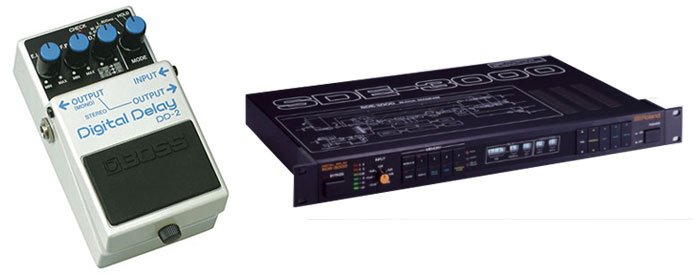 Digital delay was introduced over 30 years ago and has increased in sonic quality and usability ever since. However, the early digital delay pedals (such as the BOSS DD-2) have a certain charm and texture to them, which at this point is particularly unique because of the developments in digital delay!
The early digital delay units, like those pictured above, certainly appear limited by today’s standards but this isn’t to say that they are any less usable. In fact, the clear, crisp-yet-warm sound of early digital delay is great for adding a specific kind of textural quality to your sound.
You essentially have the best of both worlds with the Vintage Digital mode – great delay time, feedback and other modern benefits on hand, combined with the classic textural quality of early digital delay!
Digital delay was introduced over 30 years ago and has increased in sonic quality and usability ever since. However, the early digital delay pedals (such as the BOSS DD-2) have a certain charm and texture to them, which at this point is particularly unique because of the developments in digital delay!
The early digital delay units, like those pictured above, certainly appear limited by today’s standards but this isn’t to say that they are any less usable. In fact, the clear, crisp-yet-warm sound of early digital delay is great for adding a specific kind of textural quality to your sound.
You essentially have the best of both worlds with the Vintage Digital mode – great delay time, feedback and other modern benefits on hand, combined with the classic textural quality of early digital delay!
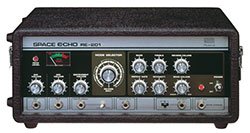 TAPE: Replicates the characteristic sound of warm, wavering tape echo. Similar to the legendary Roland Space Echo, first introduced in the 1970s.
Aptly named, the Roland Space Echo produces sounds that seem to come from outer space. Almost an instrument in itself, the Space Echo is a beloved and iconic unit that is integral to the sound of music styles such as dub reggae.
The Roland Space Echo essentially defines the sound of tape echo, so when using the Tape mode of the DD-500, you’ll have the ability to replicate this amazing sound without side-effects that were unavoidable in the original units, like tape degradation, head replacement or bulky portability.
The sound of tape echo is similar to a filtering process – higher frequencies gradually reduce over time, as the effect progresses. Combined with subtle modulation that was apparent on original tape echo units (called “wow” and “flutter”), along with the warm, compressed saturation quality that is inherent to analog tape, the Tape mode of the DD-500 gives you the classic sound of tape echo, combined with the benefits of modern usability.
TAPE: Replicates the characteristic sound of warm, wavering tape echo. Similar to the legendary Roland Space Echo, first introduced in the 1970s.
Aptly named, the Roland Space Echo produces sounds that seem to come from outer space. Almost an instrument in itself, the Space Echo is a beloved and iconic unit that is integral to the sound of music styles such as dub reggae.
The Roland Space Echo essentially defines the sound of tape echo, so when using the Tape mode of the DD-500, you’ll have the ability to replicate this amazing sound without side-effects that were unavoidable in the original units, like tape degradation, head replacement or bulky portability.
The sound of tape echo is similar to a filtering process – higher frequencies gradually reduce over time, as the effect progresses. Combined with subtle modulation that was apparent on original tape echo units (called “wow” and “flutter”), along with the warm, compressed saturation quality that is inherent to analog tape, the Tape mode of the DD-500 gives you the classic sound of tape echo, combined with the benefits of modern usability.
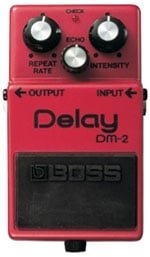 ANALOG: Adds an analog delay sound, embodied by the BOSS DM-2 which used BBD (Bucket Brigade Delay) chips for its unmistakable sound quality.
Similar to the characteristic “warm” sound that is associated with tape echo, analog delay is regarded for its enveloping and textured nature.
BOSS’ DM-2 Delay, introduced in the early 1980s, has maintained its reputation as a legendary analog delay pedal, ever since its release. Highly sought after on the used market, the DM-2 was recently re-released (and partially updated), in the DM-2W.
The DD-500’s Analog mode offers the sound of analog delay, complete with its oozing and gritty sonic inflections.
And like the similar early delay modes included in the DD-500, you now have the benefit of manipulating parameters in ways that are impossible to do on the original units!
Use the Analog mode for beautifully crunchy yet detailed results, perfect for adding a bit of “hair” to your sound!
ANALOG: Adds an analog delay sound, embodied by the BOSS DM-2 which used BBD (Bucket Brigade Delay) chips for its unmistakable sound quality.
Similar to the characteristic “warm” sound that is associated with tape echo, analog delay is regarded for its enveloping and textured nature.
BOSS’ DM-2 Delay, introduced in the early 1980s, has maintained its reputation as a legendary analog delay pedal, ever since its release. Highly sought after on the used market, the DM-2 was recently re-released (and partially updated), in the DM-2W.
The DD-500’s Analog mode offers the sound of analog delay, complete with its oozing and gritty sonic inflections.
And like the similar early delay modes included in the DD-500, you now have the benefit of manipulating parameters in ways that are impossible to do on the original units!
Use the Analog mode for beautifully crunchy yet detailed results, perfect for adding a bit of “hair” to your sound!
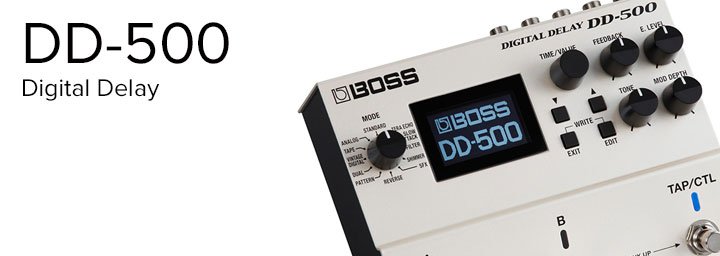
 The core of the DD-500’s gigantic flexibility is the varied delay modes available for selection, accessible via the MODE knob on the front panel.
While all of these modes are fundamentally delays, they are all different and have contrasting qualities to them which make for a diverse and inspiring palette of sound options to choose from.
You’ve probably heard many of these mode terms used before – Standard, Analog, Shimmer, Reverse, Filter, Tape…sure, they might sound self-explanatory, but what do they actually do to your sound?
One way to find out of course is to try them yourself, but if you can’t access the particular pedal that you’re after, it might be difficult to fully appreciate what these delay modes can do for you.
In this article, we’ll show you the differences between the 12 different delay modes available on the BOSS DD-500 and perhaps give you a little bit of insight as to how you might use them. In fact, to get started with some practical application – here’s a video of all 12 modes of the DD-500 in action:
Let’s take a closer look at what each Mode does and discuss how you can use each one.
Contributed by Byron Struck for the Roland Australia Blog
The core of the DD-500’s gigantic flexibility is the varied delay modes available for selection, accessible via the MODE knob on the front panel.
While all of these modes are fundamentally delays, they are all different and have contrasting qualities to them which make for a diverse and inspiring palette of sound options to choose from.
You’ve probably heard many of these mode terms used before – Standard, Analog, Shimmer, Reverse, Filter, Tape…sure, they might sound self-explanatory, but what do they actually do to your sound?
One way to find out of course is to try them yourself, but if you can’t access the particular pedal that you’re after, it might be difficult to fully appreciate what these delay modes can do for you.
In this article, we’ll show you the differences between the 12 different delay modes available on the BOSS DD-500 and perhaps give you a little bit of insight as to how you might use them. In fact, to get started with some practical application – here’s a video of all 12 modes of the DD-500 in action:
Let’s take a closer look at what each Mode does and discuss how you can use each one.
Contributed by Byron Struck for the Roland Australia Blog
MODE DESCRIPTIONS
STANDARD: This is a pristine and all-purpose digital delay. It is usable on practically any sound that requires a delay effect. Crystal clear, ideal for contemporary delay and infinitely flexible with the DD-500’s parameter controls, this is a go-to delay type for when you want an unaffected, transparent, repeated representation of your original signal. Since its explosion in the late 1970s/early 1980s, digital delay has become the most prominent type of delay available in pedals, processors, hardware and DAWs today. With the ability to replicate signals in ways that are simply not possible on tape and analog delay units, digital delay has become the industry standard for delay effects. Growing in leaps and bounds in both sound quality and usability over the 30+ years since its introduction, digital delay has the potential to range from enormous sound design textures to quiet, subtle reflection. TERA ECHO: One of BOSS’ newer effects (along with being the 100th BOSS pedal!) the Tera Echo is an echo sound that falls between both reverb and delay. It has a lot of space and adds a certain animated and lively quality to the delay sound that is excellent for ambience.
Tera Echo on the DD-500 is based on the MDP powered stompbox pedal of the same name. Combining elements of delay, filtering, reverb and pitch modulation, the complex sound produced by this effect is perfect for ambient washes or subtle reverberation with a slight edge.
Certainly one of the most exciting new innovative effects of recent times, the Tera Echo sounds incredible on clean tones for a sparkly, modulated result. However, if you use it with some overdrive or distortion, you’ll hear the highly expressive quality of its multi-faceted sonic abilities in soaring detail!
SLOW ATTACK: Slowly fades the delay effect in by affecting the attack of the delayed signal. Similar to if you were to use a volume pedal or your guitar’s volume control. Great for bringing the delay in gradually after you play something, for a building kind of sound.
You can use the Slow Attack mode to produce stunning and highly imaginative “bow-like” sounds that perfectly lend themselves to big chords, epic leads lines and clean swells. Combined with other effects like reverb and phase, you can create mesmerising soundscapes with the Slow Attack.
And, if you swap your volume pedal out for an expression pedal from the BOSS EV series line, you can now let the Slow Attack take care of your swell time and focus on controlling different aspects of your delay sound via the DD-500’s parameters, including Mod Depth or even the delay time and feedback!
FILTER: Adds a sweeping filter to your delayed signal, similar to a phaser or a flanger. Use if you want the delay sound affected by a modulation effect.
Combining a filter with a delay is like a guitar played through an overdriven amplifier – it makes perfect sense. Not only do you have the benefit of a new space added to your sound, but you’re now affecting that space with movement and a new texture.
Augmenting the original signal with new elements, highlighting your delay sound with new colours and being able to control all of these factors is ideal for taking your music into new territory. Plus, you’ll save space on your pedalboard if you want to leave your phaser or flanger at home.
For rhythmic and percussive effects, this mode is perfect. For dreamy, psychedelic washes, it works a charm. For combining multiple classic effect parameters into a highly usable and dynamic delay setting, try the Filter mode of the DD-500.
SHIMMER: A unique effect that lends a lush, textural and somewhat ethereal quality to the sound, created by pitch-shifting the delayed portion of your sound.
“Shimmer” is a term that came to prominence when artists began combining harmonizing and other pitch-based effects with delay. Originally, these different effects units were independent of each other, so for example, a delay signal was fed into a pitch-shifting unit.
This resulted in a shimmering quality to the delay sound, wavering as it progressed over time. As the “Shimmer” effect grew in popularity, it started to appear as a selectable mode on delay and other effects units, right up to today.
Because of the combination of different effects all working on your sound, the complex results that the DD-500’s Shimmer mode can deliver makes for a fantastic accompaniment to clean arpeggios. This is where you can really hear the individual note pitches shifting, after you play each one separately.
Of course, there are no rules, so experiment with the DD-500’s Shimmer mode and discover what works best for you!
SFX: Takes your delay signal and introduces a sound affecting element to it. Use for a more unusual delay signal.
Similar to the “Bit Crush” effect that has enjoyed recent popularity, the SFX mode reduces the resolution of your delay signal. This creates a lo-fi, buzzing and glitching kind of sound, similar to if you were playing an early video game!
It also has the ability to add a tremolo effect to your sound, resulting in a wavering, shaky and almost synth-like effect. The SFX mode is an unusual sounding effect for unusual purposes, but that doesn’t mean that you have to stay regulated to the world of weird sounds with it.
Using the modulation elements subtly can enhance your delay tone, giving a rough and slightly textural edge to an otherwise straightforward delay sound.
REVERSE: Reverses the delay signal, providing a backwards effect. Great for psychedelic sounds.
Certainly a more unusual-sounding delay effect, the Reverse mode might take a bit of experimenting if you’ve never played with it before. But once you get the hang of it, it’s an infinitely rewarding feature. When engaged, you’ll hear the decay of the last note you played first and the first note you actually played, last!
Similar to the “bowing” sound that the Slow Attack mode can produce, the Reverse mode will give you strange rise and fall sounds that sound even weirder once you employ extra parameter manipulation with the CTL switches.
Sure, it’s not a mode you’d use on everything but as a unique addition to your sound palette, it’s definitely worth exploring. And don’t forget, you can always store and recall a particular patch setting that you like!
PATTERN: This mode has 16 choices within it, with each one able to be set differently. It provides a rhythmic sequence to the affected signal, perfect for adding a choppy, pulsating kind of element to your delay sound.
TERA ECHO: One of BOSS’ newer effects (along with being the 100th BOSS pedal!) the Tera Echo is an echo sound that falls between both reverb and delay. It has a lot of space and adds a certain animated and lively quality to the delay sound that is excellent for ambience.
Tera Echo on the DD-500 is based on the MDP powered stompbox pedal of the same name. Combining elements of delay, filtering, reverb and pitch modulation, the complex sound produced by this effect is perfect for ambient washes or subtle reverberation with a slight edge.
Certainly one of the most exciting new innovative effects of recent times, the Tera Echo sounds incredible on clean tones for a sparkly, modulated result. However, if you use it with some overdrive or distortion, you’ll hear the highly expressive quality of its multi-faceted sonic abilities in soaring detail!
SLOW ATTACK: Slowly fades the delay effect in by affecting the attack of the delayed signal. Similar to if you were to use a volume pedal or your guitar’s volume control. Great for bringing the delay in gradually after you play something, for a building kind of sound.
You can use the Slow Attack mode to produce stunning and highly imaginative “bow-like” sounds that perfectly lend themselves to big chords, epic leads lines and clean swells. Combined with other effects like reverb and phase, you can create mesmerising soundscapes with the Slow Attack.
And, if you swap your volume pedal out for an expression pedal from the BOSS EV series line, you can now let the Slow Attack take care of your swell time and focus on controlling different aspects of your delay sound via the DD-500’s parameters, including Mod Depth or even the delay time and feedback!
FILTER: Adds a sweeping filter to your delayed signal, similar to a phaser or a flanger. Use if you want the delay sound affected by a modulation effect.
Combining a filter with a delay is like a guitar played through an overdriven amplifier – it makes perfect sense. Not only do you have the benefit of a new space added to your sound, but you’re now affecting that space with movement and a new texture.
Augmenting the original signal with new elements, highlighting your delay sound with new colours and being able to control all of these factors is ideal for taking your music into new territory. Plus, you’ll save space on your pedalboard if you want to leave your phaser or flanger at home.
For rhythmic and percussive effects, this mode is perfect. For dreamy, psychedelic washes, it works a charm. For combining multiple classic effect parameters into a highly usable and dynamic delay setting, try the Filter mode of the DD-500.
SHIMMER: A unique effect that lends a lush, textural and somewhat ethereal quality to the sound, created by pitch-shifting the delayed portion of your sound.
“Shimmer” is a term that came to prominence when artists began combining harmonizing and other pitch-based effects with delay. Originally, these different effects units were independent of each other, so for example, a delay signal was fed into a pitch-shifting unit.
This resulted in a shimmering quality to the delay sound, wavering as it progressed over time. As the “Shimmer” effect grew in popularity, it started to appear as a selectable mode on delay and other effects units, right up to today.
Because of the combination of different effects all working on your sound, the complex results that the DD-500’s Shimmer mode can deliver makes for a fantastic accompaniment to clean arpeggios. This is where you can really hear the individual note pitches shifting, after you play each one separately.
Of course, there are no rules, so experiment with the DD-500’s Shimmer mode and discover what works best for you!
SFX: Takes your delay signal and introduces a sound affecting element to it. Use for a more unusual delay signal.
Similar to the “Bit Crush” effect that has enjoyed recent popularity, the SFX mode reduces the resolution of your delay signal. This creates a lo-fi, buzzing and glitching kind of sound, similar to if you were playing an early video game!
It also has the ability to add a tremolo effect to your sound, resulting in a wavering, shaky and almost synth-like effect. The SFX mode is an unusual sounding effect for unusual purposes, but that doesn’t mean that you have to stay regulated to the world of weird sounds with it.
Using the modulation elements subtly can enhance your delay tone, giving a rough and slightly textural edge to an otherwise straightforward delay sound.
REVERSE: Reverses the delay signal, providing a backwards effect. Great for psychedelic sounds.
Certainly a more unusual-sounding delay effect, the Reverse mode might take a bit of experimenting if you’ve never played with it before. But once you get the hang of it, it’s an infinitely rewarding feature. When engaged, you’ll hear the decay of the last note you played first and the first note you actually played, last!
Similar to the “bowing” sound that the Slow Attack mode can produce, the Reverse mode will give you strange rise and fall sounds that sound even weirder once you employ extra parameter manipulation with the CTL switches.
Sure, it’s not a mode you’d use on everything but as a unique addition to your sound palette, it’s definitely worth exploring. And don’t forget, you can always store and recall a particular patch setting that you like!
PATTERN: This mode has 16 choices within it, with each one able to be set differently. It provides a rhythmic sequence to the affected signal, perfect for adding a choppy, pulsating kind of element to your delay sound.
 This is the kind of mode with which you can really add movement and a sense of dynamic evolution to your music. Where it can get really fun is if you use the DD-500’s MIDI functionality to tempo sync the Pattern delay to (or as) a Master Clock.
Do this with a drum machine like the TR-8, a DAW or any other device you’d like to jam and stay in perfect time with! As a pulse for other instruments to work around as well, you can essentially become the rhythmic backbone in an ensemble situation with this mode.
DUAL: This is a two-in-one kind of delay mode. It’s like having two different delay pedals on different settings working on your input signal at the same time! The delays can be in series or parallel (that is, you can have one delay follow the other, or have them both affecting your input signal at the same time before merging).
With this mode, you could have a shorter delay time and a longer delay time simultaneously, for creating fascinating and evolving spatial repeats. The different delay times are able to link with each other and you can also select the feedback level for each delay.
Level control for each delay is also able to be dialled in so you can have twin Tape or Shimmer delays independently working on your sound, for spectacular results!
VINTAGE DIGITAL: Reproduces the sound of early digital delay, which was predominant in the early 1980s. Similar to the BOSS DD-2, the world’s first stompbox delay pedal and Roland’s famous SDE-2000 and SDE-3000 rack units.
This is the kind of mode with which you can really add movement and a sense of dynamic evolution to your music. Where it can get really fun is if you use the DD-500’s MIDI functionality to tempo sync the Pattern delay to (or as) a Master Clock.
Do this with a drum machine like the TR-8, a DAW or any other device you’d like to jam and stay in perfect time with! As a pulse for other instruments to work around as well, you can essentially become the rhythmic backbone in an ensemble situation with this mode.
DUAL: This is a two-in-one kind of delay mode. It’s like having two different delay pedals on different settings working on your input signal at the same time! The delays can be in series or parallel (that is, you can have one delay follow the other, or have them both affecting your input signal at the same time before merging).
With this mode, you could have a shorter delay time and a longer delay time simultaneously, for creating fascinating and evolving spatial repeats. The different delay times are able to link with each other and you can also select the feedback level for each delay.
Level control for each delay is also able to be dialled in so you can have twin Tape or Shimmer delays independently working on your sound, for spectacular results!
VINTAGE DIGITAL: Reproduces the sound of early digital delay, which was predominant in the early 1980s. Similar to the BOSS DD-2, the world’s first stompbox delay pedal and Roland’s famous SDE-2000 and SDE-3000 rack units.
 Digital delay was introduced over 30 years ago and has increased in sonic quality and usability ever since. However, the early digital delay pedals (such as the BOSS DD-2) have a certain charm and texture to them, which at this point is particularly unique because of the developments in digital delay!
The early digital delay units, like those pictured above, certainly appear limited by today’s standards but this isn’t to say that they are any less usable. In fact, the clear, crisp-yet-warm sound of early digital delay is great for adding a specific kind of textural quality to your sound.
You essentially have the best of both worlds with the Vintage Digital mode – great delay time, feedback and other modern benefits on hand, combined with the classic textural quality of early digital delay!
Digital delay was introduced over 30 years ago and has increased in sonic quality and usability ever since. However, the early digital delay pedals (such as the BOSS DD-2) have a certain charm and texture to them, which at this point is particularly unique because of the developments in digital delay!
The early digital delay units, like those pictured above, certainly appear limited by today’s standards but this isn’t to say that they are any less usable. In fact, the clear, crisp-yet-warm sound of early digital delay is great for adding a specific kind of textural quality to your sound.
You essentially have the best of both worlds with the Vintage Digital mode – great delay time, feedback and other modern benefits on hand, combined with the classic textural quality of early digital delay!
 TAPE: Replicates the characteristic sound of warm, wavering tape echo. Similar to the legendary Roland Space Echo, first introduced in the 1970s.
Aptly named, the Roland Space Echo produces sounds that seem to come from outer space. Almost an instrument in itself, the Space Echo is a beloved and iconic unit that is integral to the sound of music styles such as dub reggae.
The Roland Space Echo essentially defines the sound of tape echo, so when using the Tape mode of the DD-500, you’ll have the ability to replicate this amazing sound without side-effects that were unavoidable in the original units, like tape degradation, head replacement or bulky portability.
The sound of tape echo is similar to a filtering process – higher frequencies gradually reduce over time, as the effect progresses. Combined with subtle modulation that was apparent on original tape echo units (called “wow” and “flutter”), along with the warm, compressed saturation quality that is inherent to analog tape, the Tape mode of the DD-500 gives you the classic sound of tape echo, combined with the benefits of modern usability.
TAPE: Replicates the characteristic sound of warm, wavering tape echo. Similar to the legendary Roland Space Echo, first introduced in the 1970s.
Aptly named, the Roland Space Echo produces sounds that seem to come from outer space. Almost an instrument in itself, the Space Echo is a beloved and iconic unit that is integral to the sound of music styles such as dub reggae.
The Roland Space Echo essentially defines the sound of tape echo, so when using the Tape mode of the DD-500, you’ll have the ability to replicate this amazing sound without side-effects that were unavoidable in the original units, like tape degradation, head replacement or bulky portability.
The sound of tape echo is similar to a filtering process – higher frequencies gradually reduce over time, as the effect progresses. Combined with subtle modulation that was apparent on original tape echo units (called “wow” and “flutter”), along with the warm, compressed saturation quality that is inherent to analog tape, the Tape mode of the DD-500 gives you the classic sound of tape echo, combined with the benefits of modern usability.
DID YOU KNOW?
When creating the various modes of the DD-500, the designer of the original SDE-3000, Mr. Yoshi Ikegami, personally oversaw the coding of the Vintage Digital mode to ensure absolute authenticity and dedication to the original SDE unit. BOSS sound designers also meticulously captured the behaviour and sound characteristics of the Roland RE-201 Space Echo when creating the Tape mode, for an absolute representation of the original unit, before committing it to the DD-500. This union of cutting edge design meeting decades of firsthand experience culminates in the absolute finest digital delay unit available today.
 ANALOG: Adds an analog delay sound, embodied by the BOSS DM-2 which used BBD (Bucket Brigade Delay) chips for its unmistakable sound quality.
Similar to the characteristic “warm” sound that is associated with tape echo, analog delay is regarded for its enveloping and textured nature.
BOSS’ DM-2 Delay, introduced in the early 1980s, has maintained its reputation as a legendary analog delay pedal, ever since its release. Highly sought after on the used market, the DM-2 was recently re-released (and partially updated), in the DM-2W.
The DD-500’s Analog mode offers the sound of analog delay, complete with its oozing and gritty sonic inflections.
And like the similar early delay modes included in the DD-500, you now have the benefit of manipulating parameters in ways that are impossible to do on the original units!
Use the Analog mode for beautifully crunchy yet detailed results, perfect for adding a bit of “hair” to your sound!
ANALOG: Adds an analog delay sound, embodied by the BOSS DM-2 which used BBD (Bucket Brigade Delay) chips for its unmistakable sound quality.
Similar to the characteristic “warm” sound that is associated with tape echo, analog delay is regarded for its enveloping and textured nature.
BOSS’ DM-2 Delay, introduced in the early 1980s, has maintained its reputation as a legendary analog delay pedal, ever since its release. Highly sought after on the used market, the DM-2 was recently re-released (and partially updated), in the DM-2W.
The DD-500’s Analog mode offers the sound of analog delay, complete with its oozing and gritty sonic inflections.
And like the similar early delay modes included in the DD-500, you now have the benefit of manipulating parameters in ways that are impossible to do on the original units!
Use the Analog mode for beautifully crunchy yet detailed results, perfect for adding a bit of “hair” to your sound!
Related Articles
BOSS CULT CLASSICS ECHOES IN TIME: THE HISTORY OF BOSS DELAY PEDALS BOSS PEDALS OF THE PROS TR-8 AND EFFECTS – PART 2: PEDALS EVOLUTION OF THE ROLAND SPACE ECHO THE ROLAND RE-201 SPACE ECHO STORY I HEART GUITAR: BOSS RE-20 SPACE ECHO DEMYSTIFYING THE MAGIC OF TAPE ECHO BOSS TALK: I LOVE ANALOG DELAY BUT WHAT IS A BBD? BOSS TALK: REVERB FOR GUITARISTSRelated Products


